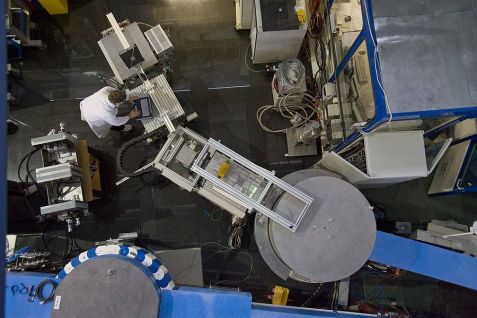MLZ is a cooperation between:
 > Technische Universität München
> Technische Universität München > Helmholtz-Zentrum Hereon
> Helmholtz-Zentrum Hereon
 > Forschungszentrum Jülich
> Forschungszentrum Jülich
MLZ is a member of:
 > LENS
> LENS > ERF-AISBL
> ERF-AISBL
MLZ on social media:

MLZ (eng)
Lichtenbergstr.1
85748 Garching
29.06.2012
Researchers observe magnetic vortices in insulator
Discovery of skyrmions in an electrical non-conductor promises a new lossless magneto-electronics.

Scientists have observed magnetic vortices in a non-conductive material at the instrument MIRA of the Research Neutron Source Heinz Maier-Leibnitz (FRM II).
Scientists led by Christian Pfleiderer succeeded in detecting magnetic vortices in so-called copper selenate (Cu2OSeO3). In 2009, the physics professor and his team from the Physics Department of the Technical University of Munich first discovered such a lattice of vortices in the magnets manganese silicide (MnSi) and iron-cobalt silicide (Fe1-xCoxSi). After the British physicist Tom Skyrme they have since been called “skyrmions”. At that time already, the scientists suspected that Skyrmions exist in many materials. But unlike the metal manganese silicide and the heavily doped semiconductor iron-cobalt silicide, the now examined copper selenate is an insulator.
At first, the copper selenate had aroused the interest of the scientists, because one can change its magnetic properties by electric fields – and vice versa. Physicists refer to materials with such properties as “multiferroic”. Inspired by studies of the Japanese colleague Yoshinori Tokura and his staff on this material, Pfleiderer and his team analyzed the copper selenate using small angle neutron scattering at the Research Neutron Source Heinz Maier-Leibnitz (FRM II) of the TUM.
Although the fundamental symmetries of the crystal structure of copper selenate are very similar to that of manganese silicide and iron-cobalt silicide, there are significant differences: A unit cell of copper selenate contains 28 instead of 8 atoms and the magnetic interactions are also considerably more complex. “The similarity of the magnetic properties of these materials was therefore rather surprising,” says Christian Pfleiderer.
The study of skyrmions in magnetic materials is emerging as a promising new field of research. A group of researchers led by Pfleiderer and his colleague Achim Rosch from the University of Cologne have recently shown that magnetic vortices can be moved by means of extremely small electric currents. This seems to be a very promising way to write magnetic information directly into materials by using electric currents. Thus, information one day could be stored even more quickly, space- and energy-saving than before. Hence the interest in science and industry is extremely large. The discovery of magnetic vortices in copper selenate now opens up new perspectives: “In a multiferroic insulator the magnetic vortices could be changed by electric fields very efficiently without losses,” says Christian Pfleiderer. Perhaps this new discovery will one day lead to a new lossless magneto-electronics.
Original Publications:
Long-Wavelength Helimagnetic Order an Skyrmion Lattice Phase in Cu2OSeO3
T. Adams, A. Chacon, M. Wagner, A. Bauer, G. Brandl, B. Pedersen, H. Berger, P. Lemmens and C. Pfleiderer
Physical Review Letters 108, 237204 (2012)
DOI: 10.11103/PhysRevLett.108.237204
Formation and rotation of skyrmion crystal in the chiral-lattice insulator Cu2OSeO3
S. Seki, J.-H. Kim, D. S. Inosov, R. Georgii, B. Keimer, S. Ishiwata and Y. Tokura
Physical Review B (Vol.85, No.22)
DOI: 10.1103/PhysRevB.85.220406
MLZ is a cooperation between:
 > Technische Universität München
> Technische Universität München > Helmholtz-Zentrum Hereon
> Helmholtz-Zentrum Hereon
 > Forschungszentrum Jülich
> Forschungszentrum Jülich
MLZ is a member of:
 > LENS
> LENS > ERF-AISBL
> ERF-AISBL
MLZ on social media:


